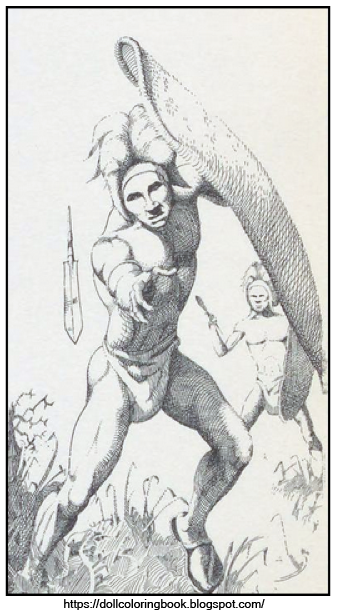 |
| The Masai throws a spear. |
South of the Sahara lies the high northern plateau, the home of the cattle-herding peoples of East Africa. From north to south the plateau is torn by deep rifts, grassy valleys where the Masai build their kraals and herd their cattle during the wet season. Although this is almost on the equator, the altitude is so high that the climate is cooler than in the tropical forests of the Congo, for in the grasslands the days are warm and sunny and the nights are cool. In the dry season many of the Masai move up onto the plateau where the grass grows three to four feet high with here and there a towering flat-topped acacia tree to break the monotony. The grass turns brown during the dry season, but it is still good for grazing.
Each elderly father of the Masai owns a kraal or encampment for his family and cattle. He chooses the site carefully, near a salt lick and in the shelter of trees. The huts are built around a fenced-in space where the cattle are kept at night, and a thick thorn-hedge surrounds the whole camp to protect it against enemies and wild animals. Each wife builds her own hut of grass plastered with mud and cow dung, which makes a hard shell. But in the rainy season the women place skins over their houses to keep the walls from being washed away. There are no windows in the huts; they are dark. But this does not matter because they are used only at night and in bad weather.
The Masai have a saying, “A cow is as good as a man,” and it is true that cattle are very important to them, being a measure of a man's wealth and position. They treat their humpbacked, great-horned cattle well. Each animal has its own name, and the master has his favorites among the herd. The Masai never kill a cow for food, but they do eat meat from other domestic animals. Milk is one of their chief foods, and they churn butter by patiently shaking a gourd for long hours until the butter comes.
Each boy of the Masai tends his father’s herds; but when he reaches the age of sixteen, a great and exciting change comes into his life. Now he is a warrior. He leaves home with the other young men of his age and lives in a kraal that their mothers have built for them. The Masai are very warlike and lord it over their neighbors. Naturally the young warriors rank high in the tribe because their special duty is to raid their neighbors for cattle and to protect their own camp from return raids.
Lion hunting is a favorite sport and proves a young man's courage. He uses no gun, but a spear, fighting the lion at close range. The successful hunter proudly flaunts the lion's mane as his headdress.
The young man leads a warrior's life until he is about thirty. Then he and the other men of his age become elders, giving up the glories of war to the younger men who have grown up to take their places. As an elder a man marries and sets up a kraal of his own. With the other elders he plans raids, but he cannot force the warriors to carry them out because he has no real authority. So, you see, each man as he grows up goes through three stages—first the boy, then the warrior, and finally the elder. But to the Masai, the life of the warrior is the most glorious. These tall, handsome people admire courage and daring and hold these qualities as ideals for their young men.
The Masai need pasturage for their cattle; so they live in widely scattered settlements. This, with their love of war and raids, may be why they have never founded a great political state like the large agricultural kingdoms in the tropical forest region of the west coast of Africa.

No comments:
Post a Comment
Thanks for your thoughts. All comments are moderated. Spam is not published. Have a good day!